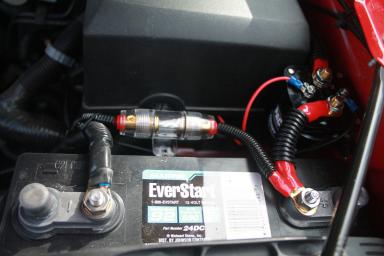If one wants to add some extra juice to run his/her performance audio equipment, there are two basic options. The first option is to ditch the OEM battery for the biggest, highest capacity battery that will fit in the available space. This is the easiest solution, and it’s typically good enough for most situations.
The other option is to replace the single battery with matched brand new batteries. This is more complicated, but it can potentially allow more reserve amperage, and in addition, one can install the second battery close to the amplifier.
Of course, it’s also important to remember that there are situations where a stiffening cap or a high output alternator will be a better idea than an extra battery.
High Performance Batteries for High Performance Audio
Since you’re in the market for more power for your performance audio equipment, what you’re really looking for is more reserve capacity. Batteries all have a number of different ratings, but two of the important ones are cranking amps and reserve capacity. Cranking amps refers to how much amperage the battery can provide at one time under a heavy load (i.e. when you are cranking the engine), and reserve capacity, usually given in ampere hours, refers to what the battery can deliver over an extended amount of time. That means you’re looking for a high performance battery that offers a lot of reserve capacity.
Depending on what car you’re driving, you may or may not have some extra space to work with where your battery is concerned. As long as a replacement battery physically fits into the allotted space, and you can safely strap it down, it’s perfectly fine to replace an OEM battery with an aftermarket one that has a significantly larger reserve capacity. And if that is an option for you, then it’s basically a matter of pulling the old battery, putting the new one in, and hooking up the battery cables. It can’t get any easier than that.
Second Batteries for High Performance Audio
The other way to add extra reserve battery capacity is to actually add a second battery. In this case, you’re typically going to get the best results by ditching your existing battery and putting in two, brand new, matched batteries. They don’t have to be the same group as the original battery, but they should be the same group (and same production date) as each other. This is essentially just to ensure that one battery doesn’t end up getting overworked, which can lead to a shortened life expectancy.
If you’re installing matched batteries, one should go right where the OEM battery was, and other needs to wire in parallel. However, the second battery doesn’t have to be next to the first one, or even in the engine compartment at all. You can install the second battery in the passenger compartment or the trunk, although you need to take precautions if you install it in the passenger compartment. You may even want to install the battery inside a solidly constructed speaker box, battery box, or another container due to the danger of it potentially exploding.
The second battery should be wired in with the thickest gauge cables that you can use, and it’s also a good idea to locate it as close as possible to your amp (or amps), since they can draw a lot of wattage, which is why you’re installing a second battery in the first place.
The Problem with Extra Battery Capacity
Whether you install a high capacity battery, or a second battery wired in parallel, it’s important to remember that you’ll only really see a benefit when the engine is off. That’s when the extra capacity really comes in handy. Whenever the engine is running, the extra battery is just an extra load as far as the alternator is concerned, which can overstress an old (or underpowered) unit.
Depending on the precise issue that you’re trying to address, you may actually be better off with a car audio capacitor than an extra battery. Although stiffening caps typically aren’t the best solution for anyone who actually enters car audio competitions, they can often solve minor problems like headlights that dim during especially loud or bass-heavy music.

How do I add a second car battery to my car?
by
Tags:
